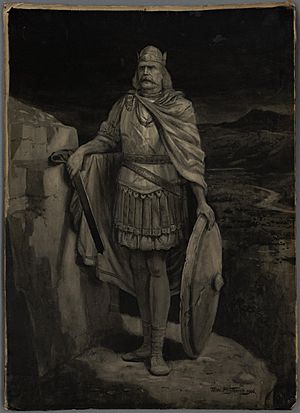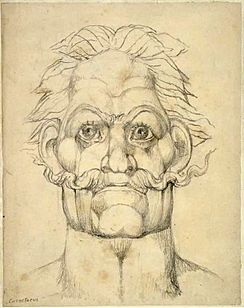Caratacus facts for kids
Quick facts for kids Caratacus |
|
|---|---|
| King of the Britons King of the Catuvellauni |
|

Caratacus before the Emperor Claudius at Rome, 18th-century print, artist unknown (British Museum)
|
|
| King of the Catuvellauni | |
| Reign | 1st century AD, to c. 50 |
| Predecessor | Epaticcus |
| Successor | None (Catuvellauni territory conquered by Claudius) |
| King of the Britons | |
| Reign | 43–50 |
| Predecessor | Cunobelinus |
| Successor | Cogidubnus |
| Born | c. 10? Probably in Catuvellauni territory |
| Died | After c. 50 Rome |
| Brythonic | *Caratācos |
| Greek | Καράτακος / Καρτάκης |
| Father | Cunobelinus |
| Mother | Unknown |
Caratacus was a brave British leader from the Catuvellauni tribe in the 1st century AD. He is famous for fighting against the Roman invasion of Britain.
Before the Romans arrived, Caratacus helped his tribe expand its lands. This success led to the Roman invasion, as they claimed to be helping his defeated enemies. Caratacus fought the Romans for almost ten years, using clever guerrilla warfare tactics. However, when he finally faced them in a big battle, he lost. After his defeat, he fled to the lands of Queen Cartimandua. She captured him and handed him over to the Romans. Caratacus was sentenced to death, but he gave a powerful speech to the Emperor Claudius, who was so impressed that he spared his life.
Some legends say that the Welsh hero Caradog ap Bran and the British king Arvirargus might be based on Caratacus. His speech to Claudius has also been a popular subject for artists.
Contents
What's in a Name?
Caratacus's name can be found spelled in a few ways, like Caratacus or Caractacus. In ancient Greek, it was Καράτακος or Καρτάκης. Modern experts believe his original British name was *Karatākos. This name means "loving," "beloved," "dear," or "friend." It is similar to the Welsh name Caradog and the Irish name Carthach.
Caratacus's Story
The Roman Invasion
Caratacus was the son of Cunobelinus, a powerful king of the Catuvellauni tribe. Caratacus helped his uncle, Epaticcus, expand their tribe's power. After Epaticcus died around AD 35, another king named Verica tried to get his land back. But Caratacus defeated him. Verica then fled to Rome and asked Emperor Claudius for help.
This gave Claudius the perfect reason to launch his invasion of Britain in the summer of AD 43. The Romans aimed for Caratacus's main city, Camulodunon (which is now Colchester). Caratacus and his brother Togodumnus led the first defense against the Roman army, which had about 40,000 soldiers. They mostly used guerrilla tactics, which means small, surprise attacks.
Despite their efforts, they lost a lot of land in the south-east after two big battles: the Battle of the River Medway and a battle near the River Thames. Togodumnus was killed in battle. The Catuvellauni's lands were taken over, and Camulodunon became the first Roman city in Britain.
Fighting On
After losing his homeland, Caratacus didn't give up. He went to Wales and led the Silures and Ordovices tribes against the Romans. The new Roman governor, Publius Ostorius Scapula, chased him for years.
Finally, in AD 50, Scapula managed to defeat Caratacus in a big battle in Ordovician territory. Caratacus's wife and daughter were captured, and his brothers surrendered. Caratacus himself escaped and fled north to the lands of the Brigantes tribe. However, the Brigantian queen, Cartimandua, captured him and handed him over to the Romans. This act led to some rebellions against Queen Cartimandua later on. With Caratacus captured, much of southern Britain became peaceful under Roman rule.
People often wonder where Caratacus's last battle took place. Some legends say it was at Caer Caradoc or British Camp in the Malvern Hills. But the Roman writer Tacitus described the battleground as having "steep mountains all around," a "stream with an unsure ford," and "rocks in front in the manner of a rampart." This description doesn't quite fit those places. Many different locations have been suggested, including Blodwel Rocks in Powys.
A Captive in Rome
After his capture, Caratacus was sent to Rome as a war prize. Usually, captives like him would be paraded through the city and then killed. But Caratacus was allowed to speak to the Roman Senate.
Tacitus wrote down a version of his speech. In it, Caratacus bravely said that his long and fierce resistance made Rome's victory even more glorious. He argued that if he had surrendered quickly, neither his story nor Rome's glory would have been as impressive. He asked them to spare him, saying he would be a lasting example of their kindness.
His speech made a huge impression. Emperor Claudius was so moved that he pardoned Caratacus and allowed him to live peacefully in Rome. After being freed, Caratacus was amazed by the city of Rome. He supposedly said, "And can you, then, who have got such possessions and so many of them, still covet our poor huts?"
Caratacus in Legends
Old Welsh Stories
Caratacus's story might have been remembered in old Welsh traditions. Some old Welsh family trees mention "Caratauc map Cinbelin," which means "Caratacus, son of Cunobelinus." This shows that the names of these historical figures were remembered correctly.
The Welsh hero Caradog ap Bran from medieval Welsh stories is also thought to be Caratacus. However, the legends about Caradog don't match Caratacus's real history, except for the name.
Two hills in Shropshire, England, are called Caer Caradoc, meaning "Caradoc's fort." These places are popularly linked to Caratacus.
Modern Tales
After people rediscovered the writings of Tacitus, Caratacus became more widely known. In the 18th century, a Welsh historian named Iolo Morganwg claimed that Caratacus, after returning from Rome, brought Christianity to Britain.
Some modern stories also connect Caratacus to early Christians in Rome. For example, Pomponia Graecina, the wife of the Roman general who conquered Britain, was accused of following a "foreign superstition." Some people believe this was Christianity. Another person, Claudia Rufina, a British woman mentioned by a Roman poet, is also linked to Caratacus in some theories.
Caratacus in Art
Caratacus has inspired many works of art:
- In John Fletcher's 1613 play Bonduca, Caratach is shown as Boudica's general, even though he lived earlier.
- He is the main character in William Mason's 1759 poem and 1776 play, both called Caratacus.
- An Italian opera titled Carattaco by Johann Christian Bach was first performed in London in 1767.
- In Gilbert and Sullivan's 1879 opera "The Pirates of Penzance", a character sings about knowing "Caractacus' uniform."
- "Caractacus" is the name of a cantata (a type of musical story) by Edward Elgar from 1897–98, which tells the story of his defeat and capture.
- A Victorian poem from 1881 by William Stewart Ross, called Caractacus the Briton, praises him as "the bravest of the brave!"
- Caratacus appears in many books, including The Dark Island by Henry Treece, Claudius the God by Robert Graves, and the Eagle series by Simon Scarrow.
- He is also a main character in Manda Scott's "Boudica" series.
- The 1964 comedy song "The Court of King Caractacus" by Rolf Harris is a humorous take on the king.
- The video game Crusader Kings II includes a "Bloodline of Caradog" that some characters can inherit.
- The Welsh artist Ellis Owen Ellis painted "Caradog before Caesar in Rome."
See also
- Caratacus Stone
- Vercingetorix, a Gallic chieftain who also fought against the Romans.



